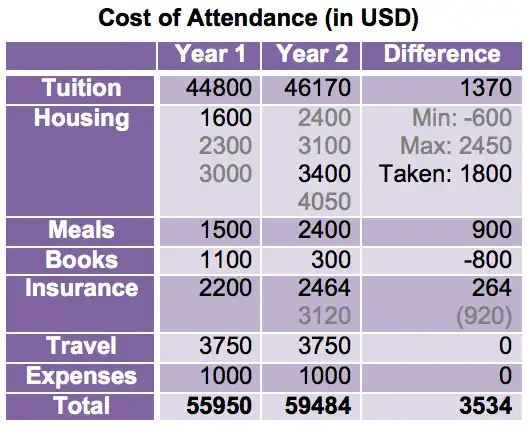多少钱? This Year's Changes in Cost of Attendance and Financial Aid
Warning: Some math and numbers ahead. The new school year is quickly rolling in, and with the upcoming semester’s payment deadline behind us, it’s time to talk about the differences in the attendance cost from last year. No doubt, many people were expecting the prices to go up somehow, seeing as we are, after all, moving to a new campus in a much more central area. But, how much more are we really paying this year? Using the figures from NYUSH’s website’s ‘Cost of Attendance’ page and a little bit of adding-and-subtracting, the number I have managed to come up with is (drumroll please): $3,534 This seemingly simple number comes with a bunch of asterisks, however, so please hear me out before you go off and start reciting it as gospel. Here is a breakdown of all the individual components that were used to come up with this number:
Tuition
This one is fairly straightforward. The website lists the tuition for 2013-14 (hereby referred to as “Year 1”) as $44,800. Year 2 (2014-15), meanwhile, brings us a cost of $46,170, making a difference of $1,370. To figure out why this is, we can look at where universities tend to actually allocate their money to here. For instance, the biggest chunk of private university tuition goes to staff salary, i.e., professors, TAs, cleaners, gardeners, etc. Another part of it goes to care of the building, electricity, and other resources. Seeing as we have more staff this year, and we now own a campus rather than renting out a part of someone else's, this all adds up to the cost. Add natural inflation and the general university tendency of raising the costs a little bit every year, and we have a rough idea of where this cost came from.
Housing
Here comes the most confusing section that doesn’t involve estimations. In Year 1, we had a choice of Triple ($1,600), Double Public Bath ($2,300) and Double Private Bath ($3,000) rooms. In Year 2, the standard is Double with bed width at either 90 cm ($3,100) or 120 cm ($3,400). Lucky draws received either a Low-Cost Double ($2,400) or a Single ($4,050). With these numbers we can see quite a spread. Theoretically, someone who lived in a Double Private could have drawn a Low-Cost Double this year, and ended up actually paying $600 less. On the other end of the spectrum, we could have someone upgrading from a Triple to a Single, resulting in an increase of $2,450. This being quite problematic for our estimation, I decided to take the most likely choice from both years (the Triple and the 120 cm Double), giving us a difference of $1,800. This rise in cost is, of course, due to our change in location and the fact that we are, after all, renting a motel, rather than living in residence halls designed for this purpose.
Books
At straightforward blanket costs, Year 1 demanded $1,100 as a flat textbook fee, while Year 2 came in with a much more humble $300, actually resulting in a difference of -$800, i.e., saving us more than last year.
Insurance
While the insurance for Year 1 was a blanket $2,200 for all, in Year 2 the cost is generally $2,464 (an email sent to us on the subject states: “Rates are higher than last year based on claims experience and the cost of healthcare in Shanghai. Additionally, the Affordable Care Act (ACA) mandated benefits resulted in higher premiums”), which gives us a difference of $264. There is an asterisk here however, and that pertains to certain US students, for whom it is $3,120 instead, due to the ACA (thanks a lot, Obama). Here, the gap is raised to a much larger $920.
Meals
Both are based off of the estimates on the webpage: $1,500 in Year 1, $2,400 in Year 2, and a difference of $900. There is large variability in this cost, depending on how much you eat, and what you eat. Furthermore, these numbers are based off of cafeteria figures, which some do not take a preference to, opting to eat out instead.
Travel
Both years estimate traveling costs at $3750: no change there. The process used to arrive at such a precise figure is frankly a mystery to me.
Expenses
Both years list miscellaneous expenses at $1,000, which I frankly disagree with for Year 2, at least, on account of Pudong’s more expensive neighborhoods, but let’s go with the numbers they gave us. Here’s the summary in easy-to-read table form:

And there you have it: My breakdown of the changes in cost of attendance. Now that we have analyzed how this upcoming year is going to feel different to our wallets, it’s time to talk about the implications this has on Financial Aid. What is the financial situation on the other end of our transaction? How are the upcoming freshmen going to be treated with this change in conditions? How different is the sum of the financial aid given to the average freshman this year from that given to the average sophomore? Is it more, is it less? Is there a reason for this? Where are we getting the majority of the aid? Who are the main benefactors? Has there been any kind of change in benefactors/funding this year? These are questions that are yet to be answered by the Bursar’s Office at NYU Shanghai. This article was written by Fikret Halilov. Send an email to news@oncenturyavenue.com to get in touch. Photo Credit: NYU